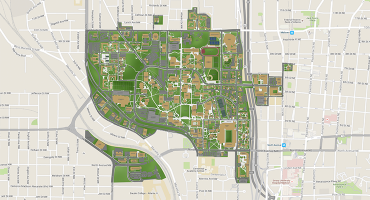Event Details
Event Details
Event Details
Event Details
Event Details
Brittaney Parks had always been interested in science, especially biology. While a junior at Chamblee High School in suburban Atlanta, she attended a ‘Women in Engineering’ program at the Georgia Institute of Technology, and saw her future.
“I thought, ‘this has been in my backyard this whole time?’ I was really interested in engineering at the time, so this became my first choice,” says Parks. “I was hooked.”
She eventually switched majors, from chemical engineering to biology, but her interest in research deepened, which has made her experience as a 2016 Petit Undergraduate Scholar all the more meaningful.
“I’d been in a lab setting before, but the Petit Scholar experience is the real deal,” says Parks, who works in the lab of Yury Chernoff, professor in the School of Biological Sciences and a researcher at the Petit Institute for Bioengineering and Bioscience. “This is what it’s like to be a research scientist.”
Parks says she had her eye on the Petit Scholars program, but a co-op opportunity with Proctor and Gamble in Cincinnati made such a commitment impossible. She applied once before, making the cut with her second effort.
The competitive Petit Scholars program is designed to develop the next generation of leading bioengineering and bioscience researchers by providing a comprehensive, yearlong research experience. Open to all Atlanta area university students, the program allows undergraduates a chance to conduct independent research in labs at the Petit Institute and other bio-focused labs at Georgia Tech.
Parks works with her mentor, Pavithra Chandramowlishwaran, on a project focused on developing a low-cost fluorescent microscope for examining neuronal activity in active circuits.
“My mentor has seen that I'm a capable person so she gives me responsibility,” says Parks, one of three Petit Scholars sponsored by pharmaceutical company UCB. “She’s encouraged me to take a more active role in planning. There's a real sense of ownership with this project."
A fifth-year student in the home stretch, Parks wants to continue her education and has been considering her options. She’s leaning toward med school, but whatever she decides, she feels her experience as a Petit Scholar has made her better equipped for whatever awaits in a biomedical career.
"What I’ve learned as a Petit Scholar can definitely be incorporated into my future goals,” she says.
Now in its 18th year, the program has supported almost 250 scholars from Georgia Tech, Morehouse College, Spelman College, Georgia State University, Emory University, Agnes Scott College, and Georgia Gwinnett College.
Applications are now being accepted for the next class of Petit Scholars.
CONTACT:
Jerry Grillo
Communications Officer II
Parker H. Petit Institute for
Bioengineering and Bioscience
Brittaney Parks had always been interested in science, especially biology. While a junior at Chamblee High School in suburban Atlanta, she attended a ‘Women in Engineering’ program at the Georgia Institute of Technology, and saw her future.
“I thought, ‘this has been in my backyard this whole time?’ I was really interested in engineering at the time, so this became my first choice,” says Parks. “I was hooked.”
She eventually switched majors, from chemical engineering to biology, but her interest in research deepened, which has made her experience as a 2016 Petit Undergraduate Scholar all the more meaningful.
“I’d been in a lab setting before, but the Petit Scholar experience is the real deal,” says Parks, who works in the lab of Yury Chernoff, professor in the School of Biological Sciences and a researcher at the Petit Institute for Bioengineering and Bioscience. “This is what it’s like to be a research scientist.”
Parks says she had her eye on the Petit Scholars program, but a co-op opportunity with Proctor and Gamble in Cincinnati made such a commitment impossible. She applied once before, making the cut with her second effort.
The competitive Petit Scholars program is designed to develop the next generation of leading bioengineering and bioscience researchers by providing a comprehensive, yearlong research experience. Open to all Atlanta area university students, the program allows undergraduates a chance to conduct independent research in labs at the Petit Institute and other bio-focused labs at Georgia Tech.
Parks works with her mentor, Pavithra Chandramowlishwaran, on a project focused on developing a low-cost fluorescent microscope for examining neuronal activity in active circuits.
“My mentor has seen that I'm a capable person so she gives me responsibility,” says Parks, one of three Petit Scholars sponsored by pharmaceutical company UCB. “She’s encouraged me to take a more active role in planning. There's a real sense of ownership with this project."
A fifth-year student in the home stretch, Parks wants to continue her education and has been considering her options. She’s leaning toward med school, but whatever she decides, she feels her experience as a Petit Scholar has made her better equipped for whatever awaits in a biomedical career.
"What I’ve learned as a Petit Scholar can definitely be incorporated into my future goals,” she says.
Now in its 18th year, the program has supported almost 250 scholars from Georgia Tech, Morehouse College, Spelman College, Georgia State University, Emory University, Agnes Scott College, and Georgia Gwinnett College.
Applications are now being accepted for the next class of Petit Scholars.
CONTACT:
Jerry Grillo
Communications Officer II
Parker H. Petit Institute for
Bioengineering and Bioscience


